Aquamarine: The March Gemstone's Rich Heritage
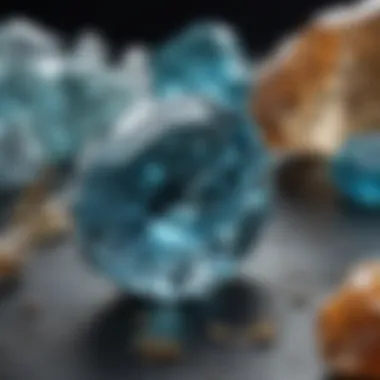
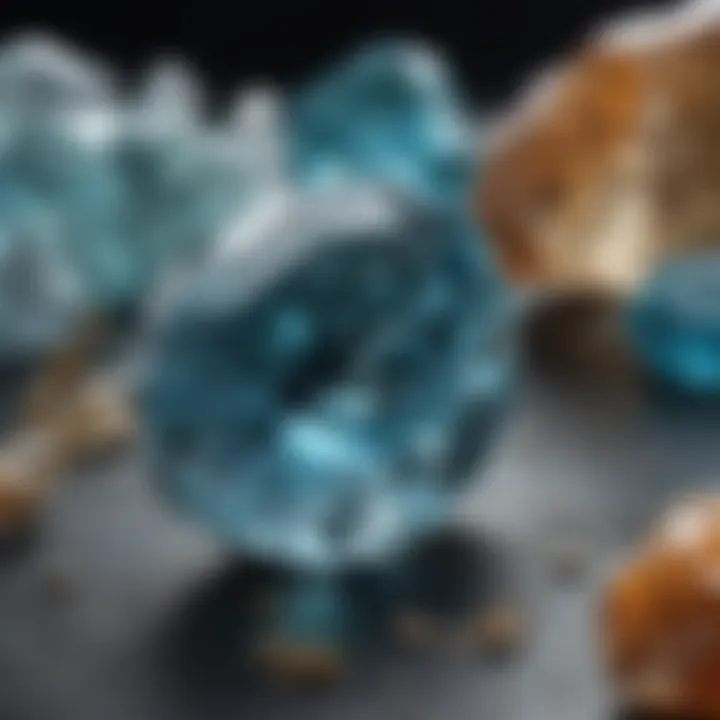
Intro
Aquamarine, the gemstone that graces the month of March, is often likened to the tranquil colors of the sea. With its stunning blue and green hues, aquamarine captivates both collectors and casual admirers alike. But its beauty is just the tip of the iceberg. As we journey through this article, we will peel back the layers that reveal its rich significance across cultures, history, as well as its metaphysical properties.
In the realm of gemstones, each carries tales and traits that invite exploration. We will dive into what makes aquamarine special, how it is classified amongst other gems, the properties that define it, and its uses in both luxurious jewelry and holistic practices. Along the way, we’ll also provide practical insights for those looking to add aquamarine to their collection or simply to better care for this historical stone.
We’ll also touch on its origins, tracing back to ancient times where it was cherished for both aesthetics and alleged powers. Prepare to embark on a journey that interweaves facts, cultural narratives, and personal insights into the world of aquamarine.
Prelims to March Birthstones
March represents a time of renewal and refreshment, a nod to the lively arrival of spring. Naturally, its birthstones reflect this vitality. Birthstones hold a wealth of meaning beyond their visual charm. They symbolize identity, offer insights into personality, and evoke emotional connections. Individuals born in March can bask in the glow of aquamarine and bloodstone, each holding unique significance. Understanding the importance of these stones can enrich relationships and decisions regarding personal ornamentation or gifting.
The Significance of Birthstones
Birthstones are not just gemstones picked randomly; they carry a history. Each month’s stone has its own lore, believed to grant protection or bestow positive attributes upon the wearer. For example, aquamarine is said to promote tranquility and courage—two qualities that are especially relevant in a world full of chaos and uncertainty. Particularly for those born in March, wearing a birthstone can serve as a daily reminder of their unique qualities and heritage, enhancing self-awareness and confidence.
Overview of March Gemstones
The two primary gemstones representing March are aquamarine and bloodstone. Aquamarine is known for its stunning blue hue, reminiscent of the ocean, which makes it a favored option in jewelry. A stone often associated with calm and communication, aquamarine reflects clarity and self-expression.
On the other hand, bloodstone, with its deep green color specked with red, brings a different energy. It’s thought to be a protective stone, thought to ward off negative energies and promote vitality. Whether one leans toward the serene hues of aquamarine or the grounding essence of bloodstone, March birthstones speak to varied types of personalities, providing a great deal of personal insight.
“The colors and attributes of a gemstone can offer fascinating insights into ourselves and others.”
In essence, understanding the intricacies of March's birthstones is vital not only for enthusiasts but also for individuals looking to connect deeply with their personal identity.
Aquamarine: The Primary March Gemstone
Aquamarine, renowned for its mesmerizing hues reminiscent of the sea, stands as the primary gemstone for those born in March. This striking stone garners appreciation not only for its beauty but also for its myriad attributes that cross realms of geology, history, and, intriguingly, healing. As part of this exploration, we’ll dive into the chemical composition that gives aquamarine its vibrancy and the various shades that impact its desirability within the gem market.
Chemical Composition and Characteristics
Aquamarine belongs to the beryl family, which boasts a variety of gems, including emeralds and morganites. The chemical formula of aquamarine is Be₃Al₂(SiO₃)₆, indicating it forms from beryllium, aluminum, and silicon. This element mix is responsible for its sky-blue color, a result of trace iron inclusions altering the light spectrum as it passes through the stone.
In terms of hardness, aquamarine sits at about 7.5 to 8 on the Mohs scale. This sturdiness makes it suitable for various types of jewelry. Very few gemstones can be trusted to weather the ups and downs of daily wear like aquamarine can. Its clarity can vary, ranging from completely transparent to slightly cloudy, with the former being significantly more desirable. There’s a sort of elegance in its crystalline structures, often found in hexagonal prisms, making it visually arresting.
Color Variations and Quality Indicators
Aquamarine gems aren’t one-size-fits-all; they come in a spectrum of colors that reflect light in different ways. The most coveted shades range from pale blue to deeper, almost teal-like blues, with the deeper hues fetching a higher price on the market. But not just any blue will do; the stone must also possess clarity. Clear aquamarines, devoid of any surface fractures or inclusions, are a sight to behold and highly sought after.
When judging quality, buyers should pay attention to:
- Color: The deeper and more vibrant the blue, the better, provided there’s clarity.
- Clarity: A flawless aquamarine is not just rare; it's vastly more valuable.
- Cut: The stone should be cut to maximize its brilliance and showcase its beauty.
- Carat Weight: Larger stones tend to command a higher price, although this is further influenced by the overall quality.
It’s also important to consider where the aquamarine comes from, as some locations are famed for producing higher-quality stones. Investing time in understanding the nuances of color and clarity will not only ensure you get the best bang for your buck but also deepen your appreciation for this enchanting gemstone.
Aquamarine is a reminder of the beauty of the sea, preserving tales of ancient mariners and channeling an aura of tranquility, making it a staple for not only collectors but anyone with a knack for elegance.
Origin and Formation of Aquamarine
Understanding the origin and formation of aquamarine is crucial not only for gemstone enthusiasts but also for those curious about the Earth's geological processes. The creation of this mesmerizing stone involves a series of intricate natural events, lending it not just aesthetic beauty but also a rich narrative that speaks to its significance in our culture and history. Appreciating aquamarine entails recognizing the interplay between elemental forces, mineral formation, and the environments in which these processes occur.
Geological Processes Leading to Aquamarine Formation
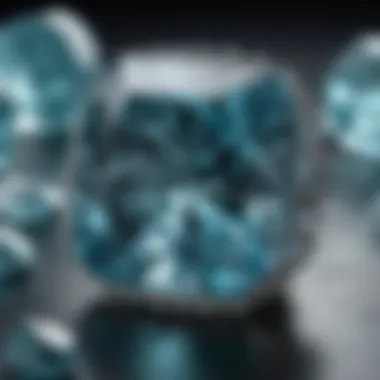
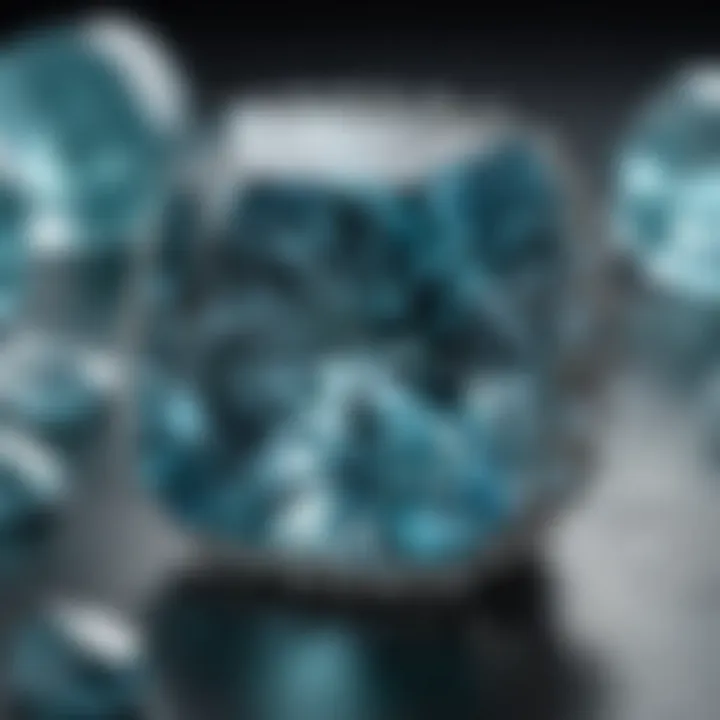
At the heart of aquamarine's formation is its status as a member of the beryl family, a group that includes several other precious stones. The life story of aquamarine begins under specific geological conditions. It forms in igneous rocks, primarily in environments where heat and pressure fuse minerals into gemstones. When beryl crystallizes, it's often in pegmatitic granite, notable for its large crystal formations.
The decisive factors involve:
- Temperature and Pressure: The ideal conditions for aquamarine formation occur at high temperatures and moderate pressures, often in regions subjected to volcanic activity. This makes certain mountain ranges like the Andes in South America fertile ground for beryl formation.
- Trace Elements: The blue hues in aquamarine owe much to trace amounts of iron. As the beryl crystal grows, various geological factors influence the presence of these elements, resulting in variations in color and clarity.
- Natural Vein Systems: Aquamarine often finds its way into veins that contain other minerals. These veins can serve as a conduit for mineral-rich solutions that ultimately crystallize into precious stones.
"Understanding how aquamarine is born from the Earth provides a deeper appreciation for this extraordinary gem, connecting the beauty of the stone with the forces that shaped it."
Major Mining Locations Worldwide
While aquamarine can be found in various places across the globe, certain mining locations stand out due to the quality and abundance of the stones. Key areas include:
- Brazil: Known as a primary source of aquamarine, regions in Minas Gerais consistently yield stunning, high-quality stones that exhibit vibrant colors and excellent clarity.
- Pakistan: The mountains of the Himalayas in Pakistan present some of the clearest aquamarine found on Earth, attracting collectors and gemologists alike.
- Nigeria: Emerging as a contender in the aquamarine market, Nigeria's deposits showcase a spectrum of blues and greens, enticing buyers looking for unique shades.
- Russia: Historical mines in the Ural Mountains have produced exquisite aquamarine specimens, further emphasizing the region’s geological richness.
- Madagascar: This island nation is gaining attention for its unique aquamarine finds, which exhibit several color variations and quality attributes.
From the depths of our planet to the jewelry counters, the story of aquamarine is a testament to the natural world's artistry. Recognizing both its origins and the geography where it is sourced is essential for anyone interested in gemstones or in acquiring great pieces that embody both beauty and history.
Aquamarine in History and Culture
Aquamarine's allure extends far beyond its aesthetics; it bears a rich tapestry of historical and cultural significance. Throughout different eras, this gemstone has woven itself into the fabric of civilizations, often representing not just beauty but also a profound connection to beliefs, rituals, and the collective human experience.
Historical Significance in Ancient Civilizations
The ancient Greeks and Romans held aquamarine in high regard, often associating it with the sea and the divine. Greek sailors believed wearing aquamarine would ensure safe passage across treacherous waters. This belief rooted in the perspective that aquamarine was a treasure from the mermaids, bestowed upon mariners as an amulet against storms. It was thought that these stones could calm the waves and protect the sailors from danger.
In Egypt, aquamarine was cherished as a symbol of clarity and vitality. It often adorned the jewelry of pharaohs and nobility, signifying not only wealth but also power. Mummies were sometimes buried with aquamarine for protection in the afterlife, echoing the belief that these stones provided safe journeys beyond this existence.
Additionally, as civilizations expanded, the belief and use of aquamarine spread throughout Asia. In China, it was seen as a stone of happiness and prosperity, woven into protective charms. Ancient cultures often recognized its role in bridging the physical and spiritual realms.
Folklore and Mythology Associated with Aquamarine
Aquamarine has also inspired a wealth of folklore and mythology across diverse cultures. In many tales, it is described as a gift from the sea, embodying the spirit of the water and the mysteries it holds. One of the most notable legends comes from the Romans, who believed aquamarine was created from the tears of mermaids. This romantic notion has persisted, coloring the stone’s perception with whimsical charm.
Another facet of aquamarine’s mythic status is its association with loyalty and friendship. Folklore suggests that gifting an aquamarine stone signifies a strong bond between friends; it is a token of loyalty, resonating with the idea that true friends are like the gemstone - enduring and beautiful in their support.
Furthermore, in modern spiritual practices, aquamarine is regarded as a stone of communication, helping with clarity in personal expression and encouraging open dialogue. This has roots in earlier traditions where it was viewed as a bearer of truth, promoting calm exchange among people.
"Aquamarine is more than a gemstone; it encapsulates centuries of beliefs, hopes, and human connections."
In summary, aquamarine's historical context and the rich folklore surrounding it highlight its significant role in human cultures over the ages. From ancient civilizations utilizing its perceived powers for protection and prosperity to the modern interpretations that celebrate communication and friendship, aquamarine continues to be more than mere jewelry; it is a vessel of cultural heritage and human expression.
The Healing Properties of Aquamarine
In the realm of gemstones, aquamarine holds a special place not only for its exquisite color but also for its reputed healing properties. Many enthusiasts believe that each stone has its own energetic signature, influencing the physical, emotional, and spiritual realms. This belief forms the foundation for why aquamarine is such a coveted stone among both collectors and those seeking healing in their lives.
Physical Healing Attributes
Aquamarine is often associated with the element of water, symbolizing calmness and clarity. Many holistic practitioners claim that aquamarine can heal various physical ailments. Its soothing blue hues are said to resonate with the throat chakra, potentially aiding in issues related to the throat, such as discomfort or inflammation. When worn or placed near this area, the stone is thought to promote better communication and self-expression, allowing one's truth to shine.
Moreover, some proponents suggest that aquamarine may assist in detoxification and support overall bodily health by strengthening the immune system. It is also regarded as beneficial for those dealing with stress-related conditions; some believe that the stone helps to alleviate anxiety and encourages emotional resilience. For instance, individuals often aim to wear or hold aquamarine during stressful situations or while undergoing medical treatments to maintain calm and focus.
"Aquamarine is like a gentle wave, washing away fears and bringing clarity with each touch."
Emotional and Spiritual Benefits
On the emotional front, aquamarine is more than just a pretty stone; it is said to serve as a powerful tool for mental clarity and peace. Many people find that carrying aquamarine helps to soothe the mind, reducing feelings of fear and providing a sense of tranquility. This makes it ideal for those grappling with emotional turmoil or challenging changes in their lives.
As for its spiritual significance, aquamarine is often linked to purification and spiritual awakening. Practitioners of meditation may utilize this stone to deepen their sessions, as its energy is believed to encourage a deeper connection to one's higher self and enhance intuition.
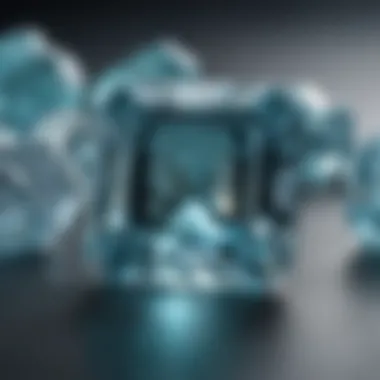
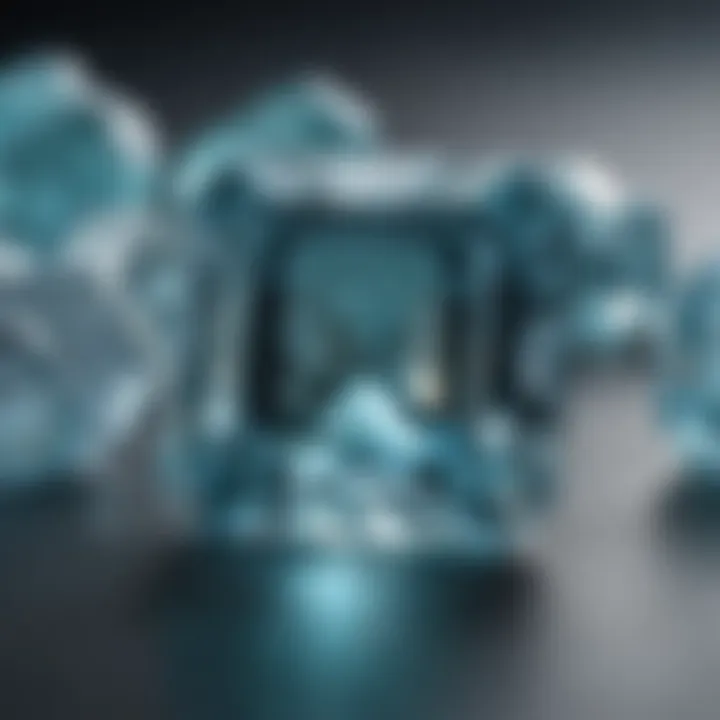
Collectors and enthusiasts often describe a sense of comfort and strength when holding aquamarine, as if the stone envelops them in a protective bubble. The act of connecting with this natural stone can facilitate personal growth and promote a greater sense of purpose.
Before embarking on your journey with aquamarine, consider setting intentions for your healing process. An intentional approach with this gem may enhance its benefits and could amplify an individual's overall experience with the stone.
Ultimately, aquamarine serves as more than just a beautiful accessory. Its multifaceted healing properties create a narrative much richer than its visual appeal, reflecting the desires for both emotional stability and physical well-being.
Choosing Quality Aquamarine Stones
When it comes to aquamarine, selecting a quality stone is paramount. This beautiful gemstone, often celebrated for its serene blue hues reminiscent of the ocean, has various characteristics that determine its value and appeal. Whether you are a collector, a jewelry designer, or simply someone who appreciates the beauty of gemstones, understanding how to choose quality aquamarine is essential for making informed decisions.
Key Features to Consider
When evaluating aquamarine stones, there are several key features to keep in mind:
- Color: The most sought-after aquamarine is a vibrant blue, akin to the best skies on a clear day. Stones that are deep blue with a slight greenish tint are also valued, but clarity plays a big role too. A vivid, pure blue without any visible inclusions is typically more desirable.
- Clarity: The better the clarity, the more light can pass through, thus enhancing its brilliance. Look for stones that are free from imperfections or prominent inclusions. Even small blemishes can have a significant impact on its perceived value.
- Cut: The style of the cut can affect both the gemstone's appearance and value. A well-cut aquamarine enhances its color and brilliance. Popular shapes include oval, round, and emerald cuts. The way a stone catches the light can really bring out the best in its hue.
- Carat Weight: Generally, larger stones command higher prices. However, don't forget that quality often outweighs size. A smaller but superior quality stone may cost more than a larger one of lesser quality.
- Treatment: Many aquamarines are treated to enhance their color. It's crucial to know whether a stone has undergone treatment, as this can impact both its value and care needs. Look for certificates from reputable gemological institutes for verification.
Finding the perfect aquamarine isn’t just about the pretty color; it’s also about its overall quality. Each of these features can influence the aesthetic and financial appeal of the gemstone.
Reputable Sources and Ethical Sourcing Practices
In today’s market, knowing where and how your aquamarine is sourced is becoming increasingly important. Ethical sourcing ensures that the stones are obtained in ways that do not harm people or the environment. Here’s what you should look for:
- Certification and Authentication: Seek vendors who can provide certification for their stones. Authenticity certificates from gemological institutions like the Gemological Institute of America (GIA) or the American Gem Trade Association (AGTA) can assure you that the aquamarine is genuine and responsibly sourced.
- Reputable Jewelers: Always buy from well-known jewelers or gemstone dealers with established reputations. Reviews and testimonials from previous clients can provide insights into their practices and the quality of their products.
- Fair Labor Practices: Ensure that the mining and production processes respect the rights of workers. Websites like Wikipedia offer insights into ethical practices in the gemstone industry.
- Traceability: Some jewelers can trace the journey of their stones from mine to consumer. This level of transparency is a good indicator that you’re purchasing from a responsible source.
- Environmental Responsibility: Look for companies that engage in sustainable practices. This can mean using eco-friendly methods for extraction or supporting local communities where the gemstones are mined.
Choosing quality aquamarine is not merely an aesthetic endeavor; it’s an ethical commitment. When you purchase responsibly sourced aquamarines, you contribute to a marketplace that values both beauty and integrity.
"The choice of a gem is not just a matter of personal preference, but a reflection of one’s values and the respect for the earth and its resources."
Understanding these features and sourcing practices sets the foundation for a fulfilling experience in the world of aquamarine, ensuring that every piece added to your collection carries not just visual beauty but significance as well.
Aquamarine in Jewelry Design
Aquamarine’s allure goes beyond its chemical properties and historical narratives; it finds its place prominently in the realm of jewelry design. This stunning gemstone brings with it not just beauty but also a sense of tranquility that has made it a favorite among jewelers and enthusiasts alike. Understanding how aquamarine is incorporated into various styles can offer insight into why it resonates with so many. Its soft blue shades are often likened to the sea and sky, invoking a fresh, calming aesthetic that many are drawn to.
The integration of aquamarine in jewelry creations can serve various purposes, from statement pieces to subtle elegance. Many artisans prefer to use this stone due to its workability and the way it adapts to different designs. Its durability, rated at 7.5 to 8 on the Mohs scale, also makes it suitable for daily wear, which enhances its appeal.
"Aquamarine is often described as the gem of the sea, a symbol of serenity and harmony, and its light, watery hue can elevate any piece of jewelry to a new realm of beauty."
Trends in Aquamarine Jewelry
Recent years have seen a surge in the popularity of aquamarine in various jewelry trends. One noteworthy trend is the movement towards sustainable and ethically sourced gemstones, which has brought aquamarine into the spotlight for conscientious consumers. More jewelers are focusing not just on the visual aspects, but also on the origins of the stones they use.
Aquamarine is showing up in unconventional designs too, departing from traditional settings. Here are some current trends:
- Mixed Materials: Many designers are combining aquamarine with metals like rose gold or reclaimed silver. The contrast between the cool blue of aquamarine and the warm tones of rose gold creates a striking visual impact.
- Nature-Inspired Designs: Emphasizing organic shapes echoes themes found in nature. This could mean settings that resemble waves or foliage, celebrating aquamarine’s watery connections.
- Statement Rings: Large aquamarine stones are being set in bold, dramatic rings that serve as conversation starters, ideal for those who want to make a statement.
- Layered Necklaces: Thin chains adorned with aquamarine pendants are gaining traction, allowing wearers to mix and match for a personalized style.
Setting Options and Design Considerations
When it comes to setting aquamarine, the choices are plentiful and can significantly affect the overall appeal of the jewelry piece. Selecting the right setting not only enhances the aesthetic but also ensures the gemstone is securely held. Here are some common settings and considerations:
- Prong Setting: This is a classic choice that allows light to pass through the stone, bringing out its natural sparkle. However, consider the height of the prongs to prevent snagging on clothing.
- Bezel Setting: This surrounds the aquamarine with a metal rim, offering a modern look and protecting the edges of the stone. Ideal for those who lead an active lifestyle.
- Halo Setting: Surrounding an aquamarine with smaller, complementary stones can create an eye-catching display, amplifying the overall brilliance of the piece.
Designers might also want to consider the cut of aquamarine. Popular cuts, like the emerald cut, highlight the stone's clarity and crisp lines, while cushion cuts can add a touch of vintage charm.
Caring for Aquamarine Jewelry
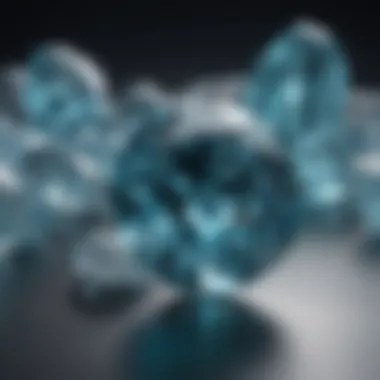
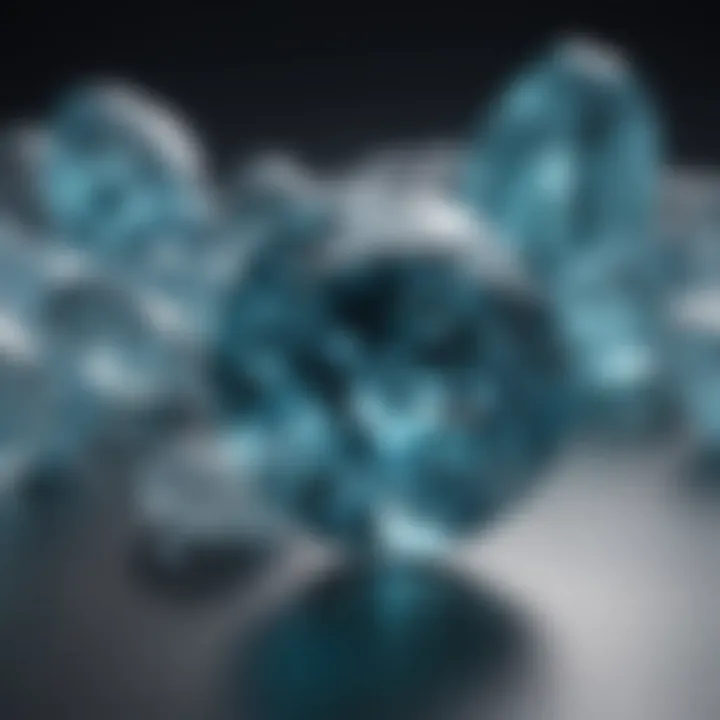
Caring for aquamarine jewelry is not just an afterthought; it's essential for maintaining the beauty and integrity of this exquisite gemstone. Aquamarine has captivated hearts with its serene blue hues reminiscent of tranquil seas. However, these lovely stones require a bit of TLC to keep them sparkling and vibrant. By understanding specific care techniques, wearers can ensure their aquamarine pieces remain cherished for years to come.
Cleaning and Maintenance Guidelines
Routine cleaning is a cornerstone of preserving the allure of aquamarine jewelry. Here are some practical steps to follow:
- Gentle Clean: Mix a few drops of mild dish soap in warm water. Soak a soft cloth in this solution and gently wipe the stone. Avoid using abrasive materials that could scratch the surface.
- Avoid Harsh Chemicals: Stay clear of strong detergents and chemicals. They can dull the finish or damage the stone over time.
- Use a Soft Brush: For settings with intricate designs, a soft-bristle toothbrush can help dislodge dirt without harming the gemstone.
- Rinse Thoroughly: After cleaning, it's vital to rinse the jewelry under lukewarm water and dry it carefully with a soft cloth.
Keeping the aquamarine stone clean helps maintain its brilliance, but remember to be gentle. The goal is to enhance its natural beauty without causing any harm.
"Regular cleaning keeps your gem’s radiance alive, but a heavy hand can dim that sparkle."
Proper Storage Techniques
Beyond cleaning, proper storage plays a crucial role in safeguarding aquamarine jewelry. Here are several methods to ensure your precious pieces remain safe:
- Use Soft Pouches or Cases: Store each piece separately in soft pouches or a jewelry box lined with fabric to prevent scratches or entanglement.
- Avoid Direct Sunlight: Prolonged exposure to sunlight can fade the color of aquamarine. Find a dark, cool spot in your home to keep your gems away from harmful rays.
- Consider Humidity Levels: Aquamarine is prone to damage from extreme temperature changes. If you live in a humid climate, consider using silica gel packs in your storage box to absorb moisture.
- Regular Inspection: Make it a habit to check your aquamarine jewelry regularly. Look for any signs of damage or loose settings that may need professional attention.
By handling aquamarine with care and giving it the attention it deserves, you ensure that it remains a staple in your collection, shining bright for every occasion.
Modern Uses of Aquamarine
Aquamarine, the shimmering blue stone celebrated for its connection to the sea, holds a special place not only in personal adornment but also in various modern practices. Its influence extends beyond jewelry to encompass healing and art, creating a multifaceted role in contemporary culture. Understanding these modern uses can enrich our appreciation of this gemstone and its significance in today’s world.
Contemporary Applications in Healing Practices
Aquamarine’s soothing properties have made it a prominent choice for alternative healing practices. It is often believed that the stone can channel energies that aid in promoting tranquility, clarity, and emotional balance. Practitioners of crystal healing frequently incorporate aquamarine in various forms, whether it's raw stones, tumbled pieces, or polished jewelry.
- Meditation and Relaxation: Many wellness enthusiasts suggest holding aquamarine during meditation sessions. The stone is thought to enhance one's ability to connect with their inner self, fostering peace and a sense of calm.
- Emotional Strength: Individuals going through stress or emotional upheaval often use aquamarine as a talisman to help alleviate anxiety. It is believed that this gemstone can assist in effective communication, encouraging individuals to express their feelings freely and honestly.
- Chakra Alignment: In the practice of chakra healing, aquamarine is associated with the throat chakra. This connection emphasizes its potential to aid in clear communication, both with oneself and others. By using aquamarine in chakra aligning rituals, individuals might find a balance between thoughts and verbal expression.
Aquamarine’s significance in these practices highlights a deep-seated belief in the healing properties of gemstones. For many, it’s not just a stone but a companion in the journey towards self-discovery and emotional well-being.
Aquamarine in Art and Symbolism
Beyond its healing properties, aquamarine has also made waves in the artistic realm. Artists around the globe have harnessed its tranquil hues and symbolic meanings to convey deeper messages through their work. Its association with water and the sky symbolizes purity, serenity, and clarity, creating a bridge between the physical and spiritual realms.
- Artistic Expressions: Aquamarine's color has inspired painters and sculptors alike, often symbolizing elements such as peace or the ocean's serenity. Artists frequently draw upon these themes to evoke emotions and provoke thought in their work.
- Symbol of Courage: Historically, sailors would carry aquamarine as a protective charm during voyages, believing it would guard them against storms and dangers at sea. This idea of protection has transitioned into modern symbolic uses, often seen in jewelry, where aquamarine is gifted to convey messages of support and encouragement.
- Cultural Representations: In some cultures, aquamarine is seen as a symbol of faith and trust. It represents calmness and is linked to the ideas of fidelity and harmony, making it a popular choice in wedding and engagement rings.
Aquamarine’s role in art and symbolism not only showcases its beauty but also highlights cultural significances that endure through time. Its versatility allows aquamarine to tap into a range of emotions and meanings, making it a stone of profound impact in the modern world.
"Aquamarine embodies the spirit of the sea and the sky, illustrating the journey from turmoil to tranquility."
Epilogue: Embracing the Blues of March
As we draw to a close in our exploration of aquamarine, it's crucial to recognize the multifaceted nature of this captivating gemstone. Aquamarine is not just a pretty face in the world of gems; it represents a rich legacy steeped in culture, history, and healing. The conclusion is a moment to reflect on what aquamarine signifies—not just for those born in March but also for anyone who appreciates gemstones. Its tranquil hues echo the calm of the ocean, while its historical roots speak to the depths of human experience with nature.
Reflecting on Aquamarine’s Rich Legacy
Aquamarine’s legacy extends far beyond its breathtaking appearance. In ancient times, sailors regarded this gemstone as a talisman, believing it to hold protective qualities against sea-related dangers. The stone was believed to calm waves, making it a cherished artifact among mariners.
Moreover, its rich connection to various cultures—whether as a birthstone, a symbol of love, or an amulet for the brave—invokes a sense of nostalgia and reverence. We can see its significance reflected in ancient jewelry designs and artifacts that have survived through centuries. The use of aquamarine in royal adornments often marked its importance, implying that it was not only valued for beauty but also for its perceived metaphysical properties.
In today’s world, aquamarine still holds profound significance. It is often linked to clarity and serenity, making it an appealing choice for those seeking solace from the chaos of life. This duality—historical significance combined with contemporary relevance—breathes new life into aquamarine, opening doors to deeper connections with both the past and the present.
Inspiration for Future Collectors
For gemstone enthusiasts and collectors, aquamarine serves as an ideal starting point. Its aesthetic appeal, coupled with its historical richness, provides ample inspiration for anyone looking to build their collection. The wide variety of shades—from pale blue to deep teal—adds versatility, making it suitable for different styles and occasions.
Aspiring collectors should consider the unique qualities aquamarine embodies. When curating a collection, think about how each piece tells a story. Do you prefer pieces with a historical background, such as Victorian jewelry, or sleek modern designs that highlight aquamarine's clarity? Each choice resonates beyond the gemstone's visual elements; it expresses personal taste and connects with a larger narrative.
Additionally, sourcing aquamarine ethically adds another layer of value to one’s collection. As more consumers become mindful of the origins of their gemstones, future collectors have the opportunity to make thoughtful choices that align with their values.



